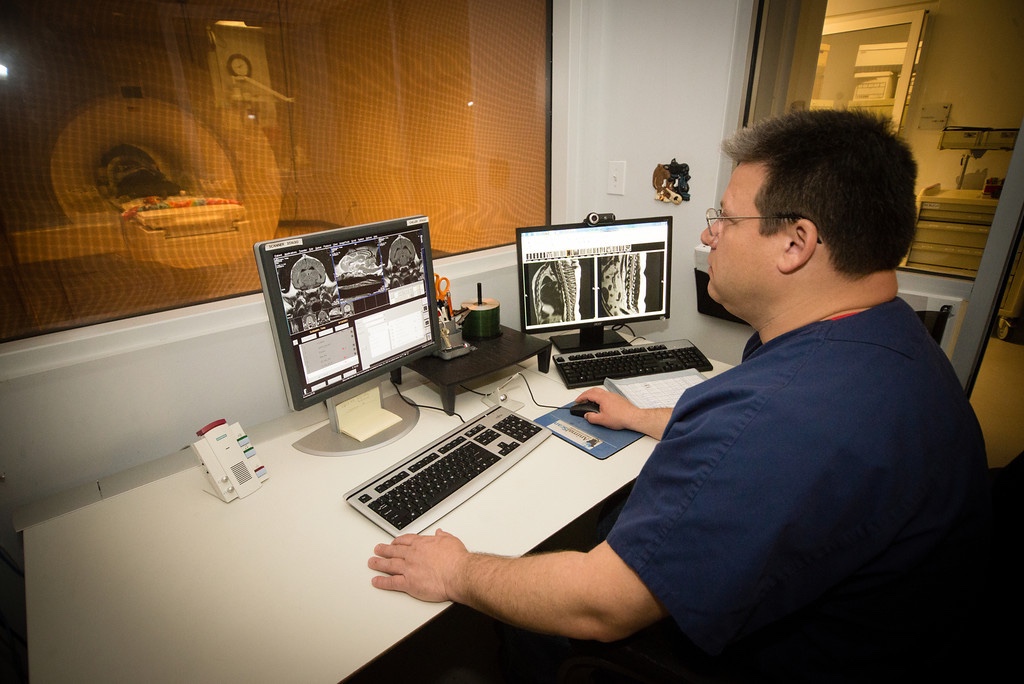Veterinary MRI Training & Applications
Veterinary MRI Training & Applications
Veterinary MRI training and applications vastly differs from its human counterpart. Consider this while sourcing your equipment. Not all equipment providers are experienced with the details of veterinary MRI. And while we often hear “veterinary MRI” providers use the term; veterinary specific coils, this matters less than you might think.
Factors that contribute to the differences in quality of imaging are:
- Variable size of patients
- Required anesthesia
- Licensing for equipment operators
- Lack of standardized quality control in the veterinary imaging industry
- Veterinary specific protocols
- Access to radiologists with meaningful MRI experience
Variable Size of Patient
Veterinary patients can be 3 pounds or 1000 pounds. It’s important to remember that the machine selected should be capable of producing quality images for your patients. Consider if a majority of your patients are 10 lb. dachshunds or mice. A low field scanner will likely not produce the necessary resolution to acquire diagnostic images. If you are imaging horses it’s important to consider the bore size of the scanner if you plan to attempt to image the stifle. If you have questions regarding the best scanner for your practice contact an AnimalScan Representative.
Required Anesthesia
Every patient that goes into an MRI requires anesthesia. You cannot simply ask the animals remain still through the banging and chirping of a 45 minute MRI scan. But, because this equipment is rarely used in human medicine, it’s important that your training and applications liaison have experience in veterinary MRI anesthesia. Veterinary MRI requires the purchase of MRI conditional anesthesia equipment. At AnimalScan we can source this anesthesia equipment or connect you with the best option for local vendors such as MRI conditional O2. We even allow our customers to lease this equipment with their scanner as an add-on item.
No Professional licensing for equipment operators
In veterinary medicine there is no legislation in place to require MRI and CT operators gain the proper credentials. These credentials ensure that they’ve completed course training at a level considered acceptable by the state. Veterinary medicine usually trains veterinary technicians to operate the scanner. This means they must cram months of training into 5-10. 5 days of training is not enough for veterinary MRI. If your vendor is only offering you 5 days, choose another vendor. They likely don’t know enough about veterinary MRI. We recommend an initial training period of 5 days and then several days of training spaced out over the course of a year. This allows your team to build on their imaging skills as they develop them.
No quality control in the veterinary imaging industry
Unlike the human medical industry, in which the FDA regulates MRI equipment sold within the U.S.A., veterinary MRI equipment providers are not obligated to uphold any imaging quality standards. That is why AnimalScan recommends and sells equipment that has already passed muster with regulators as being safe and effective. And while our coils are not “specific” to veterinary medicine, most reputable equipment manufacturers provide coils in so many flexible shapes and sizes that we have no problem re-purposing them in veterinary medicine. For example, using the knee or extremity coil for canine brains, instead of the traditional human head coil.
Veterinary Specific Protocols
Protocols are the standardized set of sequences that are run for specific body regions or when ruling out certain diseases or disorders. ACVR offers a list of these protocols recommended for Veterinary MRI scans. AnimalScan loads specific protocols for each machine as recommended by our boarded radiologists and licensed technologists. Your team will be trained on these protocols by our Applications Specialist.
Coil Use
We even use coils differently than in human medicine. For example, in veterinary medicine we usually use a knee coil to scan brains. As our patients’ sizes vary greatly its difficult to make a one size fits all even with veterinary specific designed coils. And images from a specific coil is only as good as the scanner they’re connected to.
Radiologists with meaningful MRI Experience
Where your radiologist trained, on what equipment, and how long they trained can all effect their experience in MRI reporting and their ability to effectively consult when your team needs to troubleshoot. AnimalScan specializes in MRI and CT and therefore we only hire radiologists with extensive veterinary MRI experience.
In preparation for your training week consider the following questions:
- Who will operate the equipment?
- Who will administer anesthesia and monitor the patient during the scan?
- What are you planning to do once the MRI is installed?
- Who will read the scans?
Get a quote for AnimalScan training and applications.
Contact AnimalScan
General contact form


Leave a Reply